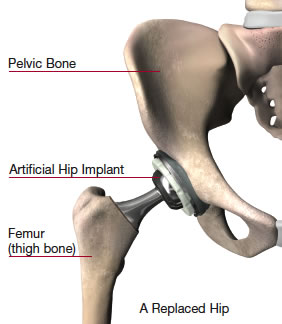Minimally Invasive Hip Joint Replacement
A Giant Step Forward in Hip Replacement
MIS Hip Joint Replacement is a step forward in hip replacement because it may provide a number of potential benefits, which may include the following: a shorter hospital stay, faster recovery, and much less scarring.1,3
As you review this website, make a note of anything you don’t understand. Your orthopaedic surgeon will be happy to answer your questions so that you’ll feel comfortable and confident with your chosen treatment plan.
Hip Replacement
Hip replacement is a surgical procedure — performed in the US since the 1960s — in which a diseased or damaged joint is replaced with an artificial joint called a prosthesis. Made of metal alloys and high-grade plastics (which are intended to mimic the function of bone and cartilage, respectively), the prosthesis is designed to move just like a healthy human joint. Over the years, hip replacement techniques and instrumentation have undergone countless improvements. Today, hip replacement is one of the safest and most successful types of major surgery; in well over 90% of cases it is complication-free and results in significant pain relief and restoration of mobility.2
“The sooner you get it done the better you’ll feel and the more your life will change.”
Carl Savino, 52
Stryker Hip Replacement Recipient

MIS Hip Joint Replacement
MIS Hip Joint Replacement is an advancement in hip replacement that offers potential important advantages over standard surgical procedures. Stryker has partnered with surgeons worldwide to develop MIS procedures and surgical instruments that will help your surgeons do their very best to help you recover your lifestyle. These techniques bring together a wide variety of high quality hip implants, new minimally invasive surgical techniques, and new instrumentation.
Minimally Invasive Surgery
Over the past 25 years, minimally invasive surgery has revolutionized many fields of medicine. Its key characteristic is that it uses specialized techniques and instrumentation that enable the physician to perform major surgery without a large incision. In this respect, MIS Hip Joint Replacement is indeed “minimally invasive,” requiring smaller incisions and potentially causing less trauma to the soft tissues than traditional techniques.
Potential Advantages
An MIS hip replacement procedure replaces the joint with a prosthesis, but requires an incision that is only 3 to 4 inches long. The procedure does not disturb as many muscles and tendons in the hip area as the classic total hip procedure.1 This allows for a potentially more natural reconstruction after the prosthesis is in place and the potential for a quicker return to normal function and activity.1,3
The smaller incision and reduced muscle disruption indicate that patients may have a shorter recovery time and less scarring.1 With MIS hip replacement, there may be less blood loss, less time in surgery and possibly a shorter hospital stay.1,3

Risks Associated with Minimally Invasive Surgery
MIS Hip Joint Replacement is less invasive than conventional Total Hip Replacement, but it is still a major surgery. It takes little additional time to complete and may result in advantages for the patient.
As with any major surgical procedure, patients who undergo total joint replacement are at risk for certain complications, the vast majority of which can be successfully avoided or treated. In fact, the complication rate following joint replacement surgery is very low. Serious complications, such as joint infection, occur in less than 2% of patients.4 (Besides infection, possible complications include blood clots, lung congestion or pneumonia.) The risks that are normally encountered in conventional hip joint replacement remain.
You Don’t Have to Live with Severe Hip Pain
You don’t have to live with severe hip pain and the limitations it puts on your activities. If you haven’t experienced adequate relief with medication or other conservative treatments, MIS Hip Joint Replacement may provide relief from pain and enable you to return to your favorite activities.
For more information visit www.aboutStryker.com and contact your doctor.
